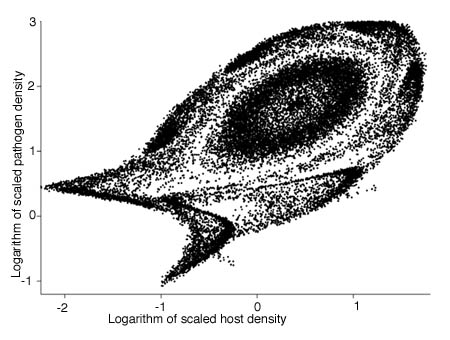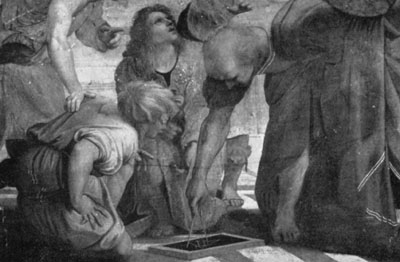
 |
Math in the Media |
![]() Mandelbrot and the Market. The Wall Street Journal for
July 27, 2004 ran a substantial
excerpt from Benoit Mandelbrot's "The (Mis)Behavior
of Markets: A Fractal View of Risk, Ruin and Reward" (Basic Books, 2004),
co-authored by
Richard L. Hudson, former managing editor of the WSJ Europe.
The Journal's introduction explains: "For the past 40 years,
Yale University mathematician Benoit B. Mandelbrot has applied his academic
theories to financial markets." It goes on to characterize his take
on the markets: "They aren't mysterious, but rather physical systems that
ought to be examined scientifically and engineered rationally." The
excerpt itself is the portrait of Richard Olsen, a Zurich-based
financial engineer specializing in foreign exchange,
and of Olsen's theory of "heterogeneous markets." "People aren't
rational," they explain, "and they don't all think alike. ...
Each one, operating on his own time scale, comes together at one moment
of trading, like all of time compressing into an instant, or the
entirety of a rainbow spectrum focusing onto one white point. That
is where the multi-fractal analysis comes in, he says: it is a
mathematical tool for decomposing the market into its different elements
and seeing how they interrelate and interact. And it suggests some
real-world trading strategies." The work has earned the Financial Times
Germany Award for the Best Business Book of the Year, to be presented
at the Frankfurt Book Fair on October 6.
Mandelbrot and the Market. The Wall Street Journal for
July 27, 2004 ran a substantial
excerpt from Benoit Mandelbrot's "The (Mis)Behavior
of Markets: A Fractal View of Risk, Ruin and Reward" (Basic Books, 2004),
co-authored by
Richard L. Hudson, former managing editor of the WSJ Europe.
The Journal's introduction explains: "For the past 40 years,
Yale University mathematician Benoit B. Mandelbrot has applied his academic
theories to financial markets." It goes on to characterize his take
on the markets: "They aren't mysterious, but rather physical systems that
ought to be examined scientifically and engineered rationally." The
excerpt itself is the portrait of Richard Olsen, a Zurich-based
financial engineer specializing in foreign exchange,
and of Olsen's theory of "heterogeneous markets." "People aren't
rational," they explain, "and they don't all think alike. ...
Each one, operating on his own time scale, comes together at one moment
of trading, like all of time compressing into an instant, or the
entirety of a rainbow spectrum focusing onto one white point. That
is where the multi-fractal analysis comes in, he says: it is a
mathematical tool for decomposing the market into its different elements
and seeing how they interrelate and interact. And it suggests some
real-world trading strategies." The work has earned the Financial Times
Germany Award for the Best Business Book of the Year, to be presented
at the Frankfurt Book Fair on October 6.
![]() Math and the Gypsy Moth.
"The combined effect of pathogens and predators on insect outbreaks"
appears in the July 15 2004 Nature. The authors (Greg Dwyer,
Jonathan Dushoff and Susan Harrell Yee) give a new mathematical model
for the pattern of outbreaks of infestation by insect
defoliators, with special reference to the gypsy moth Lymantria
dispar. Their new twist is to include in the model both a specialist
pathogen (e.g. in this case a virus that only infects gypsy moths)
and a generalist predator (e.g. a bird that eats gypsy moths but can
also eat other things).
"In this host-pathogen-predator model, stochasticity causes defoliator
densities to fluctuate erratically between an equilibrium maintained
by the predator, and cycles driven by the pathogen. Outbreaks in this
model occur at long but irregular intervals, matching the data."
Math and the Gypsy Moth.
"The combined effect of pathogens and predators on insect outbreaks"
appears in the July 15 2004 Nature. The authors (Greg Dwyer,
Jonathan Dushoff and Susan Harrell Yee) give a new mathematical model
for the pattern of outbreaks of infestation by insect
defoliators, with special reference to the gypsy moth Lymantria
dispar. Their new twist is to include in the model both a specialist
pathogen (e.g. in this case a virus that only infects gypsy moths)
and a generalist predator (e.g. a bird that eats gypsy moths but can
also eat other things).
"In this host-pathogen-predator model, stochasticity causes defoliator
densities to fluctuate erratically between an equilibrium maintained
by the predator, and cycles driven by the pathogen. Outbreaks in this
model occur at long but irregular intervals, matching the data."

| Phase portrait of the Dwyer-Dushoff-Yee model, with parameters fitting experimental data for gypsy moths, and time proceeding counterclockwise. Each dot represents one generation. For this diagram the authors introduced a stochastic element to represent random fluctuations in parameter values due to extrinsic events, mainly weather. The deterministic attractors are an elliptical quasi-periodic attractor and a 7-element phase-locked limit cycle; they manifest themselves in this image as accumulation loci. Image courtesy Greg Dwyer. |
![]() Musings on the Math Olympiad. The San Diego Union-Tribune
for August 27, 2004, published an essay by Mark H. Thiemens, the Dean of
Physical Sciences at UCSD. Entitled "Mathematics: Building a gold medal team,"
it focuses on the International Mathematics Olympiad (held in Athens
a month before the Olympic Games) and on the performance of the US 12th-grade
team (19th out of 21). "The problem for the United States is that while our scientific and technological enterprise is the envy of the world, the performance of our middle and high school students in mathematics is not."
Thiemens surveys the situation in California (ranked 36 out of 40 states
in 8-th grade mathematics performance).
"Earlier this year, the state Board of Education granted waivers to school districts up and down California, including a number in San Diego County, from a state law requiring that their high school graduates complete a course in algebra. As a result, some 13,000 students, including 600 in San Diego County, received high school diplomas this spring without this basic mathematical skill."
And he remarks:
"If the same kind of attention and concern could be focused on boosting mathematics achievement as was focused on the U.S. Olympic basketball team following its losses to Puerto Rico and Lithuania, perhaps our economic future might be more secure. "
Musings on the Math Olympiad. The San Diego Union-Tribune
for August 27, 2004, published an essay by Mark H. Thiemens, the Dean of
Physical Sciences at UCSD. Entitled "Mathematics: Building a gold medal team,"
it focuses on the International Mathematics Olympiad (held in Athens
a month before the Olympic Games) and on the performance of the US 12th-grade
team (19th out of 21). "The problem for the United States is that while our scientific and technological enterprise is the envy of the world, the performance of our middle and high school students in mathematics is not."
Thiemens surveys the situation in California (ranked 36 out of 40 states
in 8-th grade mathematics performance).
"Earlier this year, the state Board of Education granted waivers to school districts up and down California, including a number in San Diego County, from a state law requiring that their high school graduates complete a course in algebra. As a result, some 13,000 students, including 600 in San Diego County, received high school diplomas this spring without this basic mathematical skill."
And he remarks:
"If the same kind of attention and concern could be focused on boosting mathematics achievement as was focused on the U.S. Olympic basketball team following its losses to Puerto Rico and Lithuania, perhaps our economic future might be more secure. "
![]() More on the 5th posulate. La Repubblica, one of Italy's
leading newspapers, devoted a full page on August 8, 2004 to the story
of Rachid Matta, the Lebanese engineer who has recently announced a
proof of Euclid's Fifth Postulate. The article, by Gabriele Romagnoli,
is beautifully laid out and sumptuously illustrated, with portraits
of Pythagoras, Archimedes, Ptolomey and Gauss and a large
reproduction of a detail
from Raphael's "School of Athens" (Vatican Museum): Euclid instructing
his students.
More on the 5th posulate. La Repubblica, one of Italy's
leading newspapers, devoted a full page on August 8, 2004 to the story
of Rachid Matta, the Lebanese engineer who has recently announced a
proof of Euclid's Fifth Postulate. The article, by Gabriele Romagnoli,
is beautifully laid out and sumptuously illustrated, with portraits
of Pythagoras, Archimedes, Ptolomey and Gauss and a large
reproduction of a detail
from Raphael's "School of Athens" (Vatican Museum): Euclid instructing
his students.

| Euclid instructs his students in this detail from Raphael's "School of Athens" (Vatican Museum). |
-Tony Phillips
Stony Brook
|
|
|
© Copyright 2003, American Mathematical Society |